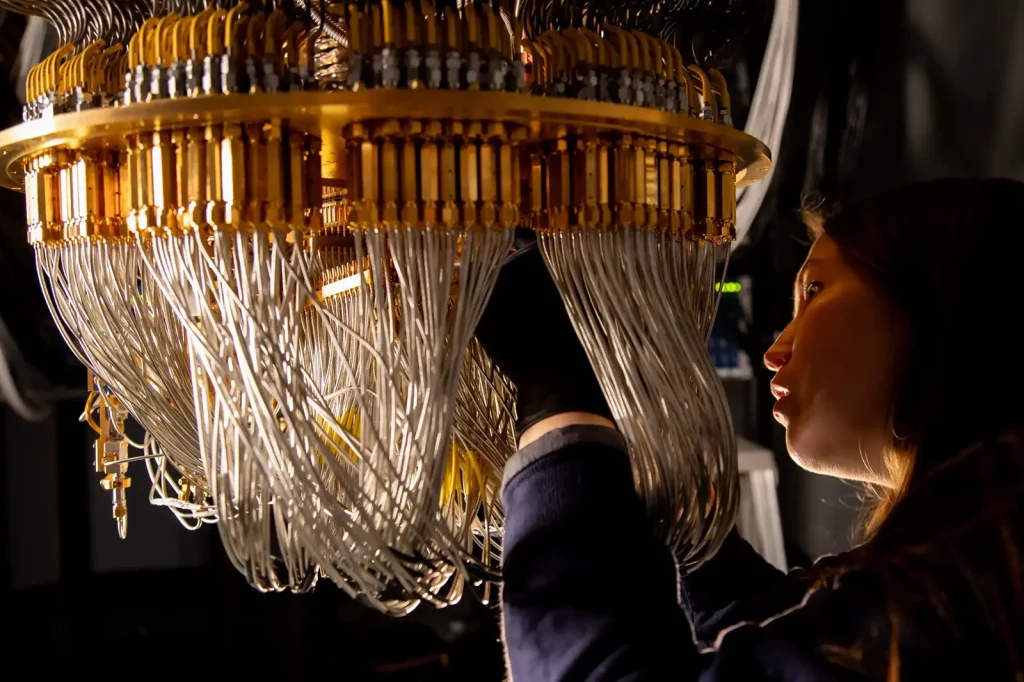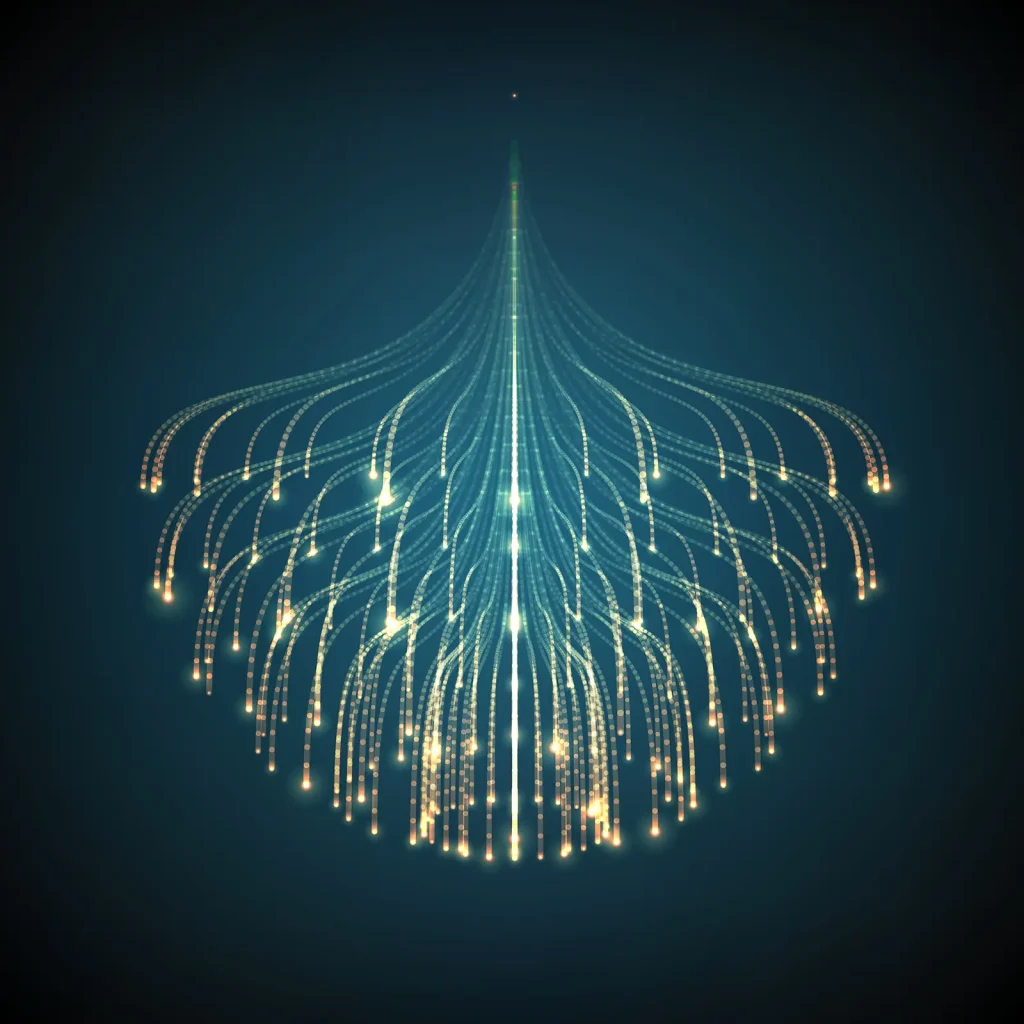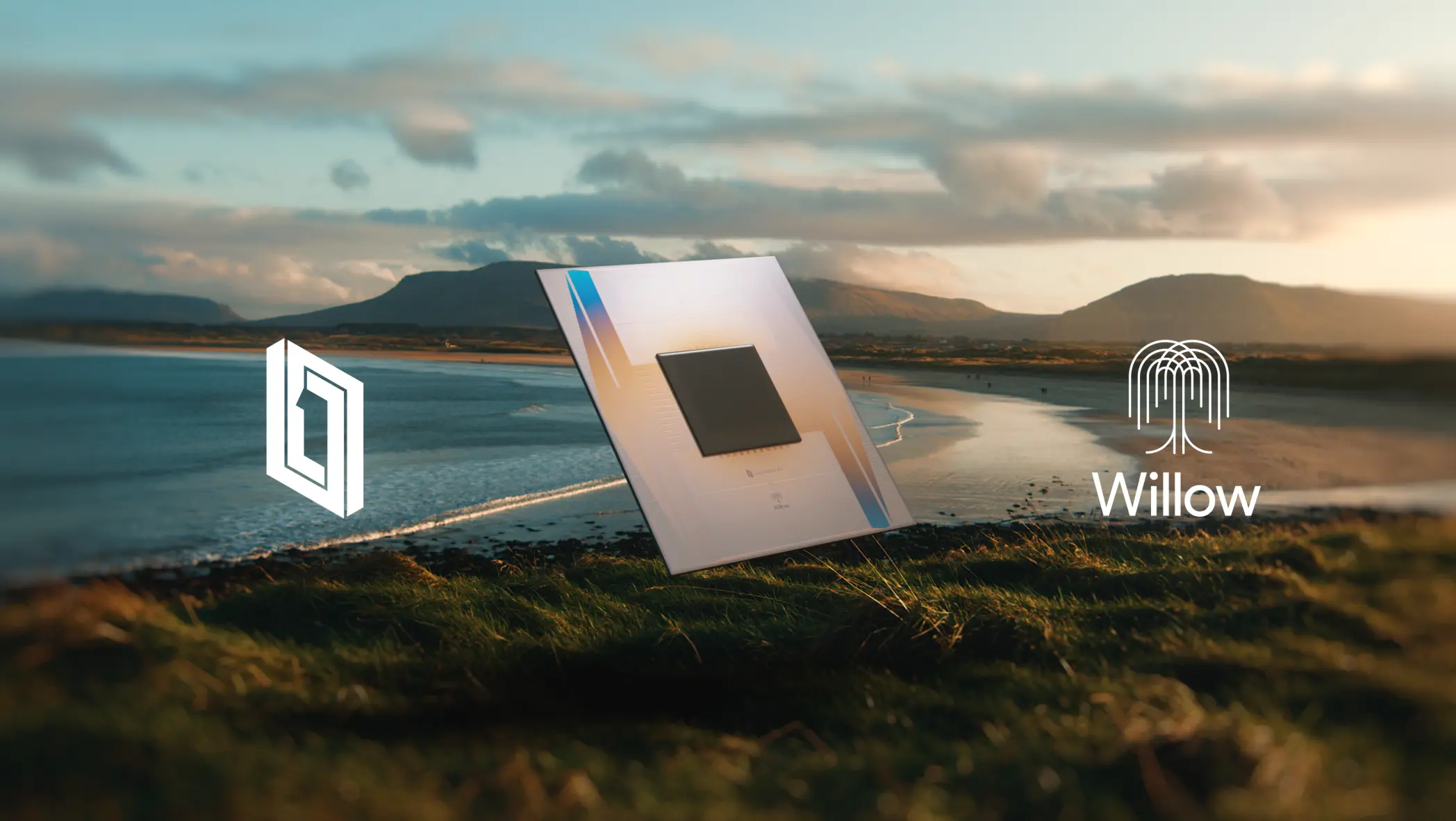Willow’s quantum chip can perform calculations in 5 minutes that would take a supercomputer 10 septillion years to perform.
Google’s quantum computing lab has reached a major milestone. The tech giant announced on December 10, 2020, that its new quantum chip, called Willow, has completed a computational challenge in less than five minutes, a challenge that Google says would take even the world’s fastest supercomputers more than 10 septillion years to solve that is, 10,000,000,000,000,000,000,000,000 years of computing on a supercomputer compared to Willow’s 5 minutes.
Willow’s achievement is a stunning improvement over the record set in 2019, when Google’s quantum Sycamore system passed the Random Orbit Sampling (RCS) benchmark. At the time, Google reported that scientists used the chip to solve a problem that would have taken a classical supercomputer 10,000 years to solve; IBM, however, disputed Google’s claim.

The RCS benchmark tests whether a quantum computer can do something that is beyond the power of a classical computer. As a standard benchmark, any team building a quantum computer must first check whether it can outperform classical computers on the RCS benchmark; otherwise, there is strong reason to doubt the computer’s ability to perform more complex quantum tasks.
But this time, Google CEO Sundar Pichai, in a powerful post on the social network X, unveiled the Google quantum computer’s solution to the “random circuit sampling” benchmark:
Willow is our new advanced quantum computing chip with a major breakthrough that can reduce errors exponentially, especially when using more qubits. This achievement solves one of the 30-year-old challenges in the field. In benchmark tests, Willow was able to solve a standard calculation in less than 5 minutes; while a state-of-the-art supercomputer would take more than 10 to the power of 25 years to do the same calculation—a time that far exceeds the current lifespan of the universe!
– Sundar Pichai, Google
In quantum computers, logic circuits use qubits instead of bits, which represent 0 or 1. Unlike a bit, which always has a fixed (quantized) value of 0 or 1, a qubit can exist in multiple states at once: any combination of zero and one.
The Willow chip is a significant advance in quantum computing hardware that delivers stunning performance. The chip uses transmon qubits, which are designed to be less sensitive to flux and charge noise, based on superconducting electrical circuits, and are made up of a Josephson junction and a capacitor. As a result, they have higher stability and coherence time than previous generations of superconducting qubits.
Hartmut Neven, Google’s vice president of engineering and founder of the Google Quantum AI Lab, described the Willow chip as a major step toward commercial applications of quantum computing; A goal he and his team have been pursuing since founding Google’s quantum AI division in 2012.
“The number of 10 septillion years of computation in 5 minutes is within reach, based on conservative assumptions”
The design team’s assessment of the quantum computer’s outperformance of the classical supercomputer Frontier was made “under conservative assumptions”; for example, the design team assumed that there would be no latency when accessing a hard drive, which is a generous and unrealistic bonus for Frontier.
As we saw after the announcement of the first superclassical computations in 2019, classical supercomputers are expected to continue to make progress in this area; but the growing gap suggests that quantum processors are advancing at twice the exponential rate of classical computers and will continue to outperform them as the number of qubits increases.

Willow was developed at Google’s new lab in Santa Barbara. The new lab is one of the few in the world designed and built specifically for the purpose of building quantum processors, the company said. From the perspective of Willow designers, system engineering plays a key role when designing and building quantum chips, because all the components of the chip, such as single- and double-qubit gates, qubit setup and readout, must be well designed and integrated simultaneously.
“Willow was designed in a lab that was originally built for quantum computing”
If any one component lags behind or two components don’t work well together, the overall system performance will suffer; therefore, maximizing system performance determines all aspects of the process, from chip architecture and fabrication to gate development and initial setup. Niven emphasizes that the achievements reported by Google don’t just report on one specific factor, but rather evaluate quantum computing systems as a whole.
Niven also explained that the reported results include several other scientific breakthroughs. “This is one of the first convincing examples of real-time error correction in a superconducting quantum system,” he said. “This is critical for any useful computation, because if you can’t correct errors fast enough, the results of the computations will be destroyed before they are even realized.”
New advances in error correction
In addition to the impressive performance, the researchers have found a way to reduce the error rate, which Google describes as “one of the biggest challenges in quantum computing.”
“Qubits inherently tend to exchange information with their environment quickly”
Qubits tend to exchange information with their surroundings quickly. Such an exchange causes the qubit to exit its quantum state and become quantized (change its value to zero or one). Typically, the more qubits there are, the more errors there are, and the quantum system becomes classical.
By adding more qubits to the quantum circuit, the Google researchers were able to correct errors at the moment they were created. To do this, they tested larger networks of physical qubits. To begin with, the experiments started with a 3×3 encrypted qubit network. As the network’s robustness increased and the additional qubits were used properly, the circuit was expanded to 5×5 and then 7×7 networks.
While larger networks have their advantages, they also come with some complications, as larger networks create more opportunities for errors to occur. If the error rate of physical qubits is too high, the extra errors become so numerous that even error correction cannot prevent their propagation; in such a situation, increasing the network size is not only not beneficial, but can also impair processing performance.
In contrast, if the error rate of physical qubits is low enough, error correction can compensate for these extra errors well. In this case, the error rate of encrypted qubits decreases exponentially, meaning that the processing accuracy improves significantly as more qubits are added.
The rate at which error correction switches from being harmful to being beneficial is called the threshold. Simply put, if the qubit error rate is below the threshold, error correction techniques can effectively solve problems and improve system performance. Niven wrote on the Google blog:
A historic achievement in this field is known as “subthreshold”—the ability to reduce errors even as the number of qubits increases. To prove real progress in quantum error correction, it is essential to show that you have reached this point. This goal has been one of the greatest challenges in the field since the concept of quantum error correction was introduced by Peter Shore in 1995.
A historic achievement in this field is known as “subthreshold”—the ability to reduce errors even as the number of qubits increases. To prove real progress in quantum error correction, it is essential to show that you have reached this point. This goal has been one of the greatest challenges in the field since the concept of quantum error correction was introduced by Peter Shor in 1995.
– Hartmut Niven, Google
Google’s achievement also demonstrates a “beyond the point of equilibrium.” In this case, the qubit arrays in the new quantum computer will have a much longer lifetime than individual physical qubits.
Niven described the breakthrough as “an undeniable sign of overall system improvement through error correction.” The technology could open up new avenues for industrial and commercial applications of quantum computers, as reducing error rates means increasing the accuracy and reliability of these systems. Details of the research and its results are published in the prestigious journal Nature.
Leading quantum computing researchers around the world have hailed Google’s achievement as a major step forward in the development of quantum computers. Barbara Terhal, a quantum error correction expert at Delft University of Technology in the Netherlands, called the achievement “a very impressive demonstration of getting below the threshold of acceptable error.” Harvard physicist Mikhail Lukin also said in an interview: “This achievement shows that this idea is quite feasible.”
Florian Neukart, former head of Volkswagen’s quantum program who has now joined Terra Quantum, said:
Google’s achievement in quantum error correction is an important step towards practical quantum computing. It addresses one of the biggest challenges: maintaining coherence and reducing errors during computation. The Willow quantum chip represents advances in hardware engineering with scalable designs focused on fault-tolerant systems.
Quantum Chip: A Gateway to Parallel Universes
The founder of Google’s quantum AI team also touted the chip’s extraordinary achievements while unveiling the Willow chip. He described Willow’s performance as being so fast that its calculations were “borrowed” from another universe.
The achievement lends credence to the theory that quantum computing occurs in many parallel universes, and is consistent with the idea of a multiverse in which we live.
– Hartmut Niven, founder of Google’s quantum AI team
The staggering number of 10 septillion years surpasses all known time scales in physics and is significantly older than the current age of the universe, estimated at about 13.8 billion years; some believe that quantum computing is actually taking place in parallel universes.
The idea of parallel universes in quantum computing is not new, of course, and was first proposed by British physicist David Deutsch. However, Niven, as a prominent technology executive, was the first to link the theory to his company’s achievements, formally describing it as “beyond this world, or rather beyond this world.”
In the many-worlds interpretation, each quantum event creates branches in the problem that split into multiple realities; for example, if a particle can exist in two states, the solution splits into two branches.
In this interpretation, each choice in the branches in the solution space is followed in a parallel universe. Interestingly, only one branch of the solution is followed in this universe at the moment of the choice; Therefore, for each branch, one can consider a parallel universe (with the chosen branch as the first option). According to this interpretation, the unchosen branches are not just unfollowed hypotheses, but solutions pursued in parallel universes.
“Every choice in the branches in the solution space of a problem is pursued in a parallel universe”
Deutsch’s theory brought this idea to the field of quantum computing. In his view, when a quantum computer performs a calculation, it processes information simultaneously in multiple parallel universes, and each calculation is performed in a separate branch; this means that quantum computers use the multiplicity of universes to solve problems.
The performance of quantum algorithms can only be fully understood if we accept the connection between parallel universes. According to Deutsch, the amazing efficiency of quantum algorithms, such as Shor’s algorithm for factoring very large numbers, can only be understood if we consider quantum computers as tools that operate in parallel universes.
The efficiency of quantum algorithms can only be understood if we accept the connection between parallel universes.
The claims made about the Willow chip are consistent with Deutsch’s theory, as the chip’s computational capabilities seem to be consistent with the description of quantum computing as an intrinsic process based on the many-universe. However, critics warn that Deutsch’s interpretation is only one of several hypotheses in quantum mechanics, and more experimental evidence is needed to confirm or refute the many-universe hypothesis.
What’s next?
With 105 qubits, Willow delivered best-in-class performance on two key metrics: quantum error correction and random circuit sampling; Google’s achievement demonstrates that it is possible to build very large and useful quantum computers, and Willow is an important step toward using practical, commercial algorithms in computational science.
However, Niven explained that the RCS problem, despite its complexity, does not yet have a direct commercial application. He clarified that the two experiments pursued different goals. On the one hand, the successful execution of the RCS benchmark proved that Willow’s system performs much faster than classical computers; but it does not yet have a known real-world application. On the other hand, scientific simulations performed on quantum systems have led to interesting scientific discoveries, but these simulations are still feasible at the computational power of classical computers.
The team led by Niven aims to bridge the gap between the two, developing algorithms that push the boundaries of classical computing and solve real-world, commercial problems.
Google is inviting researchers, engineers, and developers to join the quantum research effort using the company’s open-source software and educational resources. Google’s resources include a new Coursera course where developers can learn the principles of quantum error correction and help design algorithms that can solve future challenges, Niven said.
“Google is inviting researchers to join the course to help create the algorithms”
Google’s next goal is to achieve the first computations that surpass the capabilities of classical computers while still being relevant to real-world and commercial applications. Niven predicts that quantum technology will play a critical role in future data collection for AI training. He added that these computational achievements could lead to the discovery of new drugs, the design of more advanced batteries for electric cars, the acceleration of fusion energy research and the development of new energy alternatives.
What are your thoughts on the Willow chip? Could Google’s quantum chip pave the way for the commercialization of this type of chip?
